CHASING THE INDRI
Journey To Beauty & Chaos In Paradise Islands
Seychelles:
Sex & Politics In The Garden Of Eden

Journey To Beauty & Chaos In Paradise Islands
Seychelles:
Sex & Politics In The Garden Of Eden
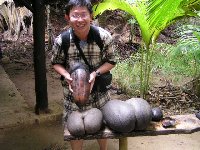 |
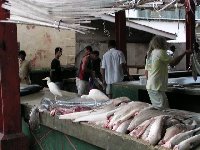 |
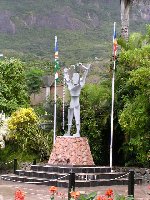 |
|
| Vallée de Mai, | Coco de Mer: Male and female seeds | Victoria's market: You share the fish with the birds... | Freedom! |
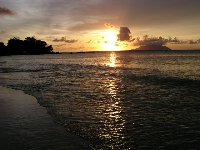 |
 |
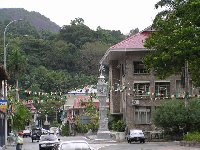 |
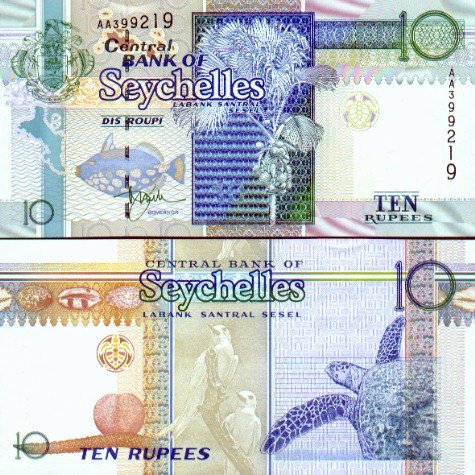 |
| Beach | Giant Tortoise | The mini Big Ben in Victoria | Banknote |
Seychelles:
Sex & Politics In The Garden Of Eden
Praslin
Island, Seychelles, Indian Ocean. Legends
say that Praslin Island is the legendary Garden of Eden, and that the famous
Coco de Mer palm – endemic and unique to the island – was the fruit of
knowledge of good and evil that led to the expulsion of Adam and Eve from
Paradise.
The
Coco de Mer is no ordinary palm. There
is a male and a female tree, both of which have seeds larger than coconuts.
By the magic of nature’s coincidence, the male seed looks like the male
organ of sexual prowess, while the female seed resembles a girl’s pelvis aka
gateway to Venus. Scientists do not yet know how the Coco de Mer reproduces.
Local legends have their own explanations: Under the light of full moon,
the male tree moves over to the female tree for a tryst of love, and any human
who witness the act of passion is condemned to death by the spell of the magical
trees.
For centuries, the legends of Coco de
Mer had fascinated many. Its fruits
are seen as aphrodisiac for kings and valued in their weight in gold.
With the “discovery” of the Seychelles, human greed and introduced
disease and creatures have wrecked havoc on this palm.
Its long maturity cycle does not help – 20 to 30 years to bear fruit,
which take 7 years to mature. Today,
the Coco de Mer is protected by the Government of Seychelles.
The export of the seed is subject to strict regulations, and the
minuscule Vallée de Mai, where the palm grows naturally, is a World Heritage
site.
----
We
arrived in Seychelles on a Saturday noon. Gentle
rain dropped as we walked out of the airport terminal, gawking at the
magnificent granite rock face overlooking the airport.
Tiny
little Seychelles – 115 sparks of gems – all sunny, humid tropical isles –
scattered across 1.35million sq km of Indian Ocean.
The entire land surface area is only 444 sq km, smaller than Singapore,
and about 2.5 times the size of Washington DC.
The largest island is Mahé, 25km long and less than 8km wide, and is
where 90% of the nation’s 80,000 people live.
According to the Congress Library Handbook, the capital, Victoria,
“lies approximately 1,600 kilometres east of Mombasa, Kenya; 2,800 kilometres
southwest of Bombay; 1,700 kilometres north of Mauritius; and 920 kilometres
northeast of Madagascar.”
----
A president with stiff-faced North
Korean bodyguards; The US military attaché aka CIA man rubbing shoulders with
his Russian counterparts in the local bar. The Cuban ambassador teaching
the final points of salsa to local babes. Leftist
revolutionaries from Latin America discussing the latest plans against the
US-backed military governments, while local dissidents plotted the latest coup
against the president with mercenaries and Israeli and South African agents.
Excitement in a tropical paradise? Or
script from a B-grade Cold War era movie?
Indeed,
this was the face of Seychelles in the Cold War days, when President France
Albert René was flirting with high socialism, with Soviet, Cuban and North
Korean advisers, even though the Americans set up a Cold War listening station
guarding the strategic approaches of the Red Sea, Persian Gulf and the Indian
Ocean sea route to Japan. Western
and Eastern diplomats and gunrunners spied on each other, turning this tiny
nation of 75,000 people into a playground of high intrigue.
Long
gone were those strange days. President
René is no longer a socialist revolutionary.
In fact, he now plays host to a massive dosage of high capitalism.
Seychelles welcomes foreign visitors – not just any visitor, but
tourists of the moneyed species, those who can afford to pay top bucks for a bit
of isolated splendour in a beautiful tropical island.
This is not a cheap seaside resort.
You pay quite a bit to fly in here and then stay at the exclusive hotels
here. Seychelles restricts the number of tourists here to 150,000 a
year (30% of the workforce are employed in tourism industry which also accounts
for 70% of the GDP) through high air fares and hotel rates.
It has avoided the blight of mass tourism that has plagued the Greek and
Spanish islands and instead turned the islands into the byword of paradises of
isolated exclusivity for the rich and famous.
----
We
stayed at a bungalow near the beaches at Beau Vallon, three kilometres west of
Victoria. I booked the place online not knowing that the 3km bird’s eye
distance on the map would involve a climb over a very tall mountain.
Perhaps it was a good thing we didn’t stay in the capital, for it was
the Independence Day holiday weekend and the tiny capital city – if you call
this oversized village of 20,000 people a city – was completely dead.
At least, at Beau Vallon, where a number of hotels are located, some
restaurants were open and we could find food.
This
benefit, however, came with a price – even a simple meal in a Seychellois
restaurant cost a bomb. Seychelles
is the most overpriced country I have ever been to.
Even a simple plate of pasta would cost at least US$15.
Everyday in Seychelles, we felt that we were been fleeced for rather
mediocre food, paying London prices for substandard stuff.
As one who had enjoyed dining in many parts of the world, I am willing to
pay good prices for good food and service, but Seychelles simply didn’t meet
the grade. Unlike other Third World
countries, tiny Seychelles has no street food and hardly any middle class of any
reasonable size that enjoy eating out. Restaurants
are for walking cash machines of a foreign kind and they should be exploited
accordingly.
Not
just food is expensive and foreigners are not the only one feeling the pinch.
Indeed, the Economist says in one of its issues:
“Every
year some 20,000 Seychellois—almost a third of the population—turn their
rupees into dollars on the black market, buy a $360 same-day return air ticket,
and go shopping in Mauritius, nearly 2,000 kilometres (1,240 miles) to the
south. No island economy can survive that sort of drain for long. That it is
cheaper to shop in Mauritius is an indication of the astronomical cost of living
in the Seychelles, where prices are driven up by unnecessarily expensive imports
and a currency that may be overvalued by as much as 30%.”
----
Seychelles
is Africa’s richest nation, with a GDP per capita of US$7600. There is free schooling and healthcare, and the population is
generally well educated. Population
growth rate is 0.4%, well below replacement and most untypical of other African
nations. Life expectancy is 71
years, also among the highest in Africa – in fact above the global average.
Medical care is free and easily available – perhaps the legacy of the
President René’ s socialist days. So
is birth control and hence the low population growth.
Life is easy and relaxing, almost stress-free – perhaps this accounts
for the rather high life expectancy here.
It
is said that 75% of the children here are born out of wedlock, the result of
high cost of traditional marriages, and perhaps a certain island lifestyle
thing. Sexual relationship without
marriage is common here and carries little social stigma.
According to the Congress Library Handbook, “most family units take the
form of de facto unions known as living en
ménage.
One result of this practice is that nearly three-fourths of all children born in
the islands are born out of wedlock. Most of these children are, however,
legally acknowledged by their fathers.”
Perhaps
this is the effect of that fabled aphrodisiac,
Coco de Mer, whose huge female seed appears everywhere in Seychelles as its
tourism logo. It’s on stamps,
stickers, postcards, t-shirts, cookies, drinks, and even as passport stamps!
If you have a pelvis staring at you everywhere all the time – albeit a
plant seed larger than a coconut – your thoughts turn to sex too!
---
Like
Mauritius, Seychelles belongs to a strange breed of Commonwealth members who are
more French than British. It was
the Arabs who first came across these sunny tropical isles, and the French who
first settled here. In fact, the
name “Seychelles” honours a French minister of finance under King Louis XV.
These islands are small, perhaps too small for large scale cultivation,
but they do have some strategic importance, and resources to exploit.
In fcat, between 1784 and 1789, an estimated 13,000 giant tortoises were
shipped from Mahé, (capital and name of the largest island, named after a
French admiral) presumably as ingredients for turtle soup, essential diet for
the many sailors on the route to the fabulous riches of the East.
In
1814, the islands were finally awarded to the British at the Treaty of Paris,
after decades of endless ownership switch with France.
It was said that prior to that, the island’s French aristocracy would
lower the French tricolour and raise the Union Jack whenever the British fleet
is seen in the horizons; And then raise the tricolour again when the fleet
leaves harbour.
The
local French brought here African slaves to work on their farms; the Chinese,
Indians and Malays came as well, mostly to run small shops and manage trivial
commerce. Because the islands were
so isolated, intermarriage was common among all groups.
In fact, so few families were of pure descent that by 1911, official
records no longer distinguish the population according to race.
Everybody is known as Seychellois, and they all speak Creole – the
Seychellois version developed from a southern French dialect to include words
from Malagasy, Bantu and Hindi - as the mother tongue, which was officially
declared the first official language in 1981.
The Kreol Institute set up by the government is the official sponsor of
the tongue, and plays the role of the Academie Francaise and the like in these
isles.
----
We
took a 15 minutes’ turbulent flight to the island of Praslin, burning a 100
Euro hole in our pockets. This is
the country’s second most popular destination and home to the Coco de Mer. The streets are narrower, but clean and tidy.
The Seychellois do take pride in maintaining public cleanliness although
I was to be disappointed by the state of the Vallée de Mai National Park.
The latter, where we paid a ridiculous US$15 entrance fee, which was only
2km long and 2km wide, had nothing more than a poorly maintained circle trail
strewn with collapsed palm leaves and logs and faded signboards.
It makes you wonder what they do with the entrance fees, which is much
greater than other more important and better-maintained World Heritage Sites
round the world such as Stonehenge and the Great Wall of China.
The
same goes for other attractions. The
even smaller Botanical Gardens, where we visited the giant Aldabran Tortoises
– distant cousins of the Galapagos giant tortoises of the east Pacific (see my
travelogues on http://groups.yahoo.com/group/twc-nomad/message/144
) - charged us a cut-throat US$5 to see its tiny confines.
----
Seychelles
became independent in 1976 and soon saw its first coup less than a month before
its first anniversary of independence. Pro-Western
President Mancham was overthrown while on a visit to London, by his Prime
Minister, René, who claimed the support of the plantation workers, proletariat
and all the oppressed classes classical Marxists proclaimed as toilers of the
land. This was the beginning of a
decade and a half of one-party rule in Seychelles and coup attempts and high
intrigue between the two men, both London-educated lawyers who gave what could
be largely personal political struggle an ideological coating so common in the
days of the Cold War. Even then,
pragmatic Seychelles play host to a US Air Force satellite tracking station,
which supplement the national budget to a tune of US$4.5 million a year.
René
turned the country into a one party state and flew the flag of socialism, while
accusing Mancham, now heading a government-in-exile in London, as enemy of the
people. Mancham and
company launched a number of counter-coups, the most well known one being an
attempt by a group of mercenaries in 1981, who tried to enter the country by
disguising as South African tourists, but were exposed at the airport. With their leader, Colonel Michael "Mad Mike" Hoare,
they promptly escaped by hijacking an Air India plane to South Africa.
René quickly obtained help from his socialist allies in Tanzania, which
sent troops to guard these unhappy isles of Paradise.
A national army was set up, called the Seychelles People’s Liberation
Army (what does that remind you of?), in order to guard the regime from hostile
groups such as the Movement for Resistance (Mouvement pour la Résistance), the
Seychelles Liberation Committee, and the Seychelles Popular Anti-Marxist Front.
Seychelles
only returned to multiparty politics in 1991, as the winds of democracy blew
across the world. Even then, dear
old President René, sixty-seven years old master of Paradise, and
socialist-turned-capitalist, won the elections in 1993 with 60% of the votes. Life goes on.
----
To
say the least, we were hardly impressed with Seychelles.
It was overpriced and there was little life on the streets.
Maybe its population is too small. Maybe
they all prefer to stay at home to watch TV.
Apart from a few less than impressive banners, there were hardly any
signs of celebration on its Independence Day.
Although
the Seychellois people are a friendly lot and generally helpful when you ask for
directions, they are not exactly the fastest people to respond to customer
service. Maybe life is just so easy
and slow here. People take a long
time to serve you in restaurants and shops.
Maybe work isn’t the most exciting thing on Earth.
According to the Economist, there is massive abuse of the social security
system, as “there were 526,000 visits to a health clinic in a
country of under 75,000 people.”
When
we were waiting for a bus to bring us to Victoria the first working day after
the Independence Day long holiday weekend, a local told us that she wasn’t
sure whether the bus would come at all, for the driver might have spent the
weekend drinking. Sometimes the bus
would come really late, and she would be late for work.
Sometimes it would come early and she would be on time.
Why worry since you can’t control matters, she said, and so what if you
were late.
It
seems that Seychellois are hardly concerned about the pace and quality of
service. Maybe this is the essence
of island life. But because nobody
complained about the standard of service, they would continue to get such poor
service. Nobody seems to be
interested if tourists are concerned about poor service at high prices.
How
can such economies compete in a globalised world?
Maybe Paradises don’t need to compete at all.
Or what they thought.
----
Seychelles
has faced a currency crisis over the last two years.
The Seychelles Rupee has dropped 25% over that period.
The country’s isolated geography and limited resources meant that it is
highly dependent on imports. The
Seychelles Rupee is pegged at an artificially high level which has come under
immense pressure after September 11, 2001, which seriously impacted tourist
numbers. Tourism comprised 70% of the country’s GDP and tourist
arrivals have declined by 27% in 2002.
This
is not helped by the fact that strict price controls instituted in the 1980’s
by the Socialist-era Seychelles Marketing Board, a state monopoly chaired by the
President that controls all primary produce, has accelerated the decline of
decline of agriculture in Seychelles, and continue to impact negatively on
non-tourism economic activities here. The
country has further defaulted on debts owed to foreign governments and
international agencies such as the African Development Bank and the World Bank.
In
response, the government has imposed further capital controls, which has
resulted in the appearance of a black market in the Seychelles Rupee.
Everywhere there are signs warning tourists to change money with
authorised banks and moneychangers. All
hotel bills, entrance fees and airfares are to be paid in US$.
My past experience is, if a country requires you to settle simple
transactions like entrance fees and hotel bills not in its own currency, you
know that currency is not worth its weight in toilet paper.
It’s no different from what I have encountered in Serbia or Cuba.
What
really irritated us was that, when we were leaving the country, we discovered
that we could not exchange our remaining Seychelles Rupees into an international
currency without paying a commission of US$10, whereas no commission was charged
if you convert another currency to Seychelles Rupees.
So we decided to buy some local newspapers and overpriced postcards
instead.
With
that, we hopped onto an Air Seychelles plane for Moroni, capital of the Comoros,
a group of islands on the Mozambique Channel between the African continent and
the huge island state of Madagascar.
Best
Regards,
Wee
Cheng
![]() Comoros: Volcano,
Decay & Illusions In The Islands of The Moon
Comoros: Volcano,
Decay & Illusions In The Islands of The Moon
![]() Send
your comments to Tan Wee Cheng, Singapore
Send
your comments to Tan Wee Cheng, Singapore
![]() Back to Homepage of CHASING THE INDRI
Back to Homepage of CHASING THE INDRI
![]() Back to the Main Homepage of Weecheng.com
Back to the Main Homepage of Weecheng.com